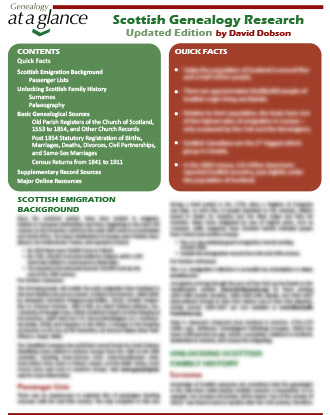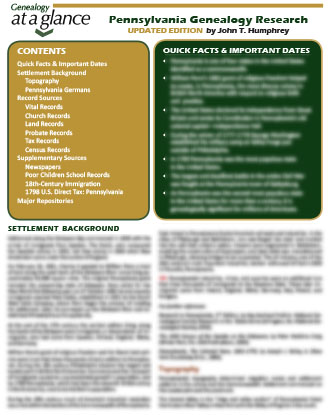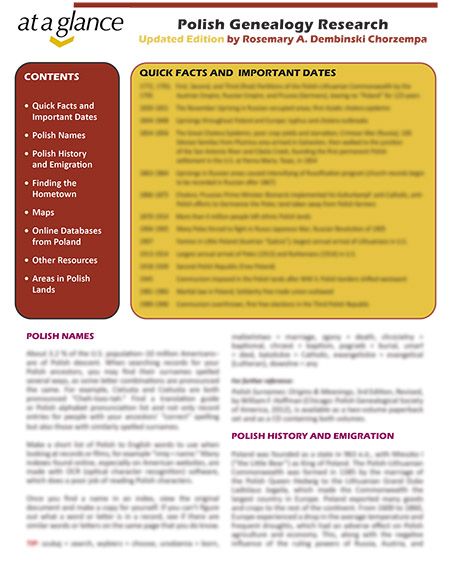
NGSQ reviews Updated Editions of Our Scottish, Polish, and Pennsylvania “At a Glances”
From time to time we like to share reviews of our publications as published in genealogy magazines, periodicals, and online. By doing so, we can not only take pride in the good things others are saying about our books but also let you consider how various authorities have come to regard them. The September 2020 issue of the National Genealogical Society Quarterly (pp. 231-234) featured reviews of three recently updated titles in our “Genealogy at a Glance” series of laminated genealogy guides: Scottish Genealogy Research, by David Dobson; Pennsylvania Genealogy Research, by John T. Humphrey; and Polish Genealogy Research, by Rosemary A. Chorzempa. We’ve reprinted those three reviews below.
Genealogy at a Glance: Scottish Genealogy Research. Updated ed.
By David Dobson. Published by Genealogical Publishing Co., Inc.; 3600 Clipper Mill Road, Suite 229; Baltimore, MD 21211-1953; genealogical.com; 2020. ISBN 978-0-8063-2101-1. 4 pp. Laminated and folded. $9.95.
Dr. David Dobson has produced useful guides to Scottish genealogy and family history for decades. Many of his titles deal with Scottish emigration. That this quick guide leads with the topic is not surprising. The updated edition takes into account several developments since Dobson’s first quick guide appeared in 2010. Online access to records through the Scotlands People website has been available since 2008. In 2011 the National Archives of Scotland and the General Register Office for Scotland, located next to each other in central Edinburgh, combined to become the National Records of Scotland. This change along with other developments, such as the vast increase in the number of online searchable databases for Scottish genealogy and history, made the need for an updated Scottish Genealogy Research guide apparent.
The author packs much useful information into four pages. Each section includes basic facts on a specific topic, followed by how to access information online and in print. An overview of the contents at the top of the first page is followed by a section on emigration. The next segment, “Unlocking Scottish Family History,” covers surnames and paleography, particularly the early modern forms of handwriting that researchers find challenging. Next comes “Basic Genealogical Sources” including the Old Parish Registers of the Church of Scotland; the Statutory Registers of Births, Marriages, and Deaths beginning in 1855; and the decennial censuses from 1841 to 1911. The “Supplementary Record Sources” cover wills and testaments, monumental inscriptions, Kirk session records, inheritance and property transfers, chartered town and city records, estate and family papers, and maritime and tax records. The guide ends with a section addressing principal online resources.
Dr. Dobson has done well to upgrade his handy and easily portable guide. Beginners in Scottish genealogical research will want to supplement the outline form with a selection of the various current books on the subject, which explain terminology and types of records available in more detail. More advanced researchers will find that the guide provides a convenient checklist of sources to review before setting out for a record repository or to review when at a facility to make certain one has not forgotten a particular category. This Dobson guide will be packed in my suitcase on my next trip to Edinburgh.
Norman D. Nicol, PhD
Harvey’s Lake, Pennsylvania
ndnicol@epix.net
Genealogy at a Glance: Pennsylvania Genealogy Research. Updated ed. By John T. Humphrey. Published by Genealogical Publishing Co., Inc.; 3600 Clipper MN Road, Suite 229; Baltimore, MD 21211-1953; Genealogical.com; 2020. ISBN 978-0-8063-2100-4. 4pp. Laminated and folded. $9.95.
Pennsylvania research poses unique challenges. Because of William Penn’s grant of religious freedom, Pennsylvania became the most religiously and ethnically diverse of the thirteen colonies. Many Americans’ family history research leads them back to Pennsylvania as it was the most populous state at the time of the first federal census in 1790 and boasted the second highest population in the nation for more than a century.
Providing a comprehensive overview of such a long and diverse history within the space of four pages is a daunting task. The late John T. Humphrey achieved this feat in Genealogy at a Glance: Pennsylvania Genealogy Research. Humphrey’s expertise in Pennsylvania research is evident as he packed each section of this guide full of fundamental information and resources. This 2020 edition updates Humphrey’s original 2012 work adding newly available online databases and indexes along with updated URLs and citations.
The guide begins with a succinct overview of Pennsylvania facts, dates, settlement background, and topography. Humphrey shares insight into his specialty, Pennsylvania Germans, the largest non-English speaking group of early settlers. He covers the major categories of record sources (vital, church, land, probate, tax, and census) with savvy tips and book suggestions for further reference. In the “Supplementary Sources” section he presents a few lesser-known, but valuable sources including poor children school records, this reviewer’s personal favorite. The guide concludes by highlighting five major repositories with brief descriptions of their collections.
A key strength of this new edition is the updated URLs which link researchers directly to specific collections for focused and efficient searches. This is an incredibly helpful tool for readers who may be new to these records. There are a few inconsistencies with the provision of URLs, however. For example, when discussing the Septennial Census, a link to this collection could have easily been added. Similarly, the URL provided for the 1798 U.S. Direct Tax Lists leads to a descriptive pamphlet, not the record images themselves. A link to the collection would have been more consistent and user-friendly.
With the vast array of Pennsylvania resources, every experienced researcher could make an argument for a repository or source that has proven invaluable and might have made Humphrey’s “short list.” However, given the task of distilling nearly 350 years of history and records of the current sixty-seven counties into four pages of prioritized information, Humphrey managed to encapsulate the essential highlights. His guide equips those new to the intricacies of Pennsylvania research to hit the ground running with the best of the best at their fingertips.
Kristin R. Wenger
Lititz, Pennsylvania
Kristin@RootsAndWingsResearch.com
Genealogy at a Glance: Polish Genealogy Research. Updated ed. By Rosemary A. Chorzempa. Published by Genealogical Publishing Co.Inc.; 3600 Clipper Mill Road, Suite 229; Baltimore, MD 21211-1953; genealogical.com; 2020. ISBN 978-0-8063-2104-2. 4 pp. Laminated and folded. $9.95.
This 2020 edition replaces the 2013 Genealogy at a Glance: Polish Genealogy Research by the same author. Like its cousins, the QuickSheets and Portable Genealogist series, Genealogy at a Glance laminated guides provide genealogists with a lightweight, durable, compact tool to carry along to research repositories or on trips.
In this updated edition, Polish-American expert Chorzempa distills her classic Korzenie Polski: Polish Roots, 2nd ed. (Genealogical Publishing Co., 2014) into the minimum needed for beginning Polish genealogy research. In four pages, she provides background information on the history of Poland (p 1) and an explanation of why so many Polish immigrants indicated they were from Austria, Prussia, Russia, or Germany instead of Poland when responding to U.S. officials or enumerators (p. 2). She lists current websites that genealogists can use to access vital resources for identifying an old-country hometown or village (p. 2). Chorzempa includes links to important online databases in Poland and in the United States for genealogical research (p. 3). Finally, on the fourth page, she provides a four-language guide to place names with English, Latin, Polish and German equivalents. For relevant locations, she adds helpful information for Ukrainian or Russian origins, but does not include any Cyrillic entries or translations of place names.
It is a daunting task to condense complicated content and research methodology without oversimplifying it. Chorzempa does a masterful job of maintaining the essence of Polish genealogical research for novices. Since additional information on the Polish language, pronunciation, and unique alphabet is crucial to finding Polish ancestors, more experienced researchers will want to consult Chorzempa’s book (above) or Jason Kruski’s A Guide to Chicago and Midwest Polish-American Genealogy, 2nd ed. (Clearfield, 2018). Kruski’s book, which includes methodology that goes beyond the midwestern United States, would be a valuable addition to Chorzempa’s list of “Other Resources” (p. 3).
Beth A. Stahr, MLS, CG
Loudon, Tennesseebstahr@bellsouth.net






